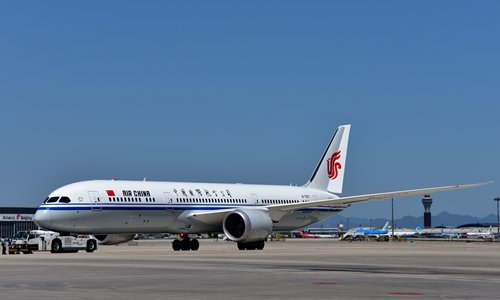Airline giants post strong annual profits
Carriers face competition from booming railway industry, fuel costs

A Boeing 787-9 passenger jet of Air China is towed at Beijing Capital International Airport in 2016. File photo: IC
China's major airlines recently released their annual profits for 2017, with all reporting a jump in profit due to soaring travel demand.
Air China said on Tuesday that its net profit in 2017 rose 6.3 percent to 7.24 billion yuan ($1.15 billion), its strongest profit increase since 2011. Meanwhile, China Southern Airlines Co posted a 17 percent jump in profit and Hainan Airlines reported a net profit of 3.3 billion yuan, up 6 percent compared to its net income of 3.1 billion yuan in 2016.
China Eastern Airlines had not released its financial report as of press time.
Those numbers mean that the three airline giants contributed substantially to the overall robust growth of the domestic aviation market witnessed in 2017.
Air China said that the level of outbound travel in the industry is continuously increasing, causing the demand for international flights to soar. At the same time, its cargo sector has witnessed a recovery due to an increase in global demand, with the airline noting that its cargo revenue jumped 23.5 percent in 2017 alone.
China Southern, which is based in Guangzhou, South China's Guangdong Province, said that the number of transfer passengers traveling through its main hub at Guangzhou Baiyun International Airport grew by 24.2 percent year-on-year while its transfer revenue grew 22.6 percent year-on-year.
According to the Civil Aviation Administration of China (CAAC), in 2017, China remained the world's second-largest aviation market, with a total annual freight transport turnover of 108.31 billion ton-kilometers, representing a year-on-year growth rate of 12.5 percent.
In detail, the number of domestic and regional passengers reached 500 million, representing a year-on-year growth rate of 13.7 percent. The number of international passengers reached 55.442 million, representing a year-on-year growth rate of 7.4 percent. Meanwhile, the total domestic aviation freight volume reached 7.058 million tons, representing a year-on-year growth rate of 5.7 percent.
CAAC has predicted that 2018 could see the high demand trend continue, forecasting a passenger growth rate of more than 10 percent for the year.
Looming challenges
However, despite the strong forecasts and 2017's climb in growth, numerous factors, including a pickup in fuel prices, a boom in high-speed rail travel, the prospect of interest rate hikes and fluctuations in exchange rates, are posing challenges and bringing uncertainties to the industry.
The three airlines said that each of their fuel costs are now at more than 28 percent, with Air China in particular noting that its fuel costs now stand at 29.2 percent, or 6.42 billion yuan, the highest fuel cost rate among the three giants.
Air China also said that currency fluctuations remain a risk as a 1 percent change in the yuan against the dollar could lead to a 279 million yuan shift in net profit.
All three companies have pointed out that the rapid development of China's high-speed railway system could pose a big threat to their performances in the future, as the train network has almost completed the construction of four horizontal and four vertical transportation arteries spanning the entire country.
The National Development and Reform Commission said earlier that the country's entire railway system could extend by as much as 150,000 kilometers by 2020, with that number including a 30,000 kilometer high-speed railway line increase. However, since Air China does not operate as many domestic short- and medium-haul routes as its peers, which are challenged by train journeys of a similar length, the impact of railway expansion on the airline's overall performance will be limited.
Future strategy
As for future development, competition over slots at major domestic airports is becoming increasingly tense and it is getting ever more difficult for carriers to tap airports in first- and second-tier cities.
Because more carriers have been placing an increasing number of planes at domestic airports, competition has even been spreading as far as third- and fourth-tier cities.
Air China noted that since domestic airlines operating with wide-body aircraft are actively involved in the development of remote, second-tier markets, it has brought about a kind of diversion effect from its hub operations in first-tier cities.
In 2009, there were only three second-tier airports operating long-haul international routes longer than 5,000 kilometers. By December 2017, however, such flights were being operated in 21 second-tier airports across the nation, Air China said, adding that those airports have developed so much in recent years that they now have destinations across Europe, the Americas, Australia and Africa. This demonstrates the recent exponential growth of second-tier markets.
Despite the fierce competition, the three airline giants are nevertheless still holding on to the strategy of accelerating intercontinental routes as their main form of expansion.
Hainan Airlines, for example, said it will amplify its intercontinental route network in second-tier cities while China Southern said it is expecting a more prominent position in its Guangzhou hub, attempting to expand in Beijing and establishing more routes connecting China with overseas destinations.

